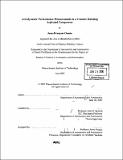| dc.contributor.advisor | Alan H. Epstein. | en_US |
| dc.contributor.author | Onnée, Jean-François | en_US |
| dc.contributor.other | Massachusetts Institute of Technology. Dept. of Aeronautics and Astronautics. | en_US |
| dc.date.accessioned | 2006-03-29T18:44:16Z | |
| dc.date.available | 2006-03-29T18:44:16Z | |
| dc.date.copyright | 2005 | en_US |
| dc.date.issued | 2005 | en_US |
| dc.identifier.uri | http://hdl.handle.net/1721.1/32434 | |
| dc.description | Thesis (S.M.)--Massachusetts Institute of Technology, Dept. of Aeronautics and Astronautics, 2005. | en_US |
| dc.description | Includes bibliographical references (p. 165). | en_US |
| dc.description.abstract | This thesis is an experimental investigation of the aerodynamic performances of a counter-rotating aspirated compressor. This compressor is implemented in a blow-down facility, which gives rigorous simulation of the characteristic aerodynamic parameters in which a compressor operates in steady state conditions. To measure the efficiency of this unique machine, the total temperature as well as the total and the static pressures at the inlet and the outlet of the compressor are measured. Due to the short test time ([approx.]100 ms) and unsteady nature of the blow-down environment, performance measurements in a short-duration test facility place especially demanding requirements on the accuracy and the response of the temperature and pressure sensors. For the total temperature probes, 0.0005-inch-diameter type-K thermocouple gage wires were assembled in specially designed casings allowing to perform measurements at determined span and circumferential locations. As for pressure probes, ultraminiature piezo-resistive transducers were used. The uncertainties related to their performances is estimated. These results are then processed to obtain an estimation of the uncertainties in the efficiency measurement. The error related to the time-resolution as well as the discrete spatial sampling pattern are also assessed. The blow-down test facility provides a quasiisothermal environment. The non-adiabatic effects lead to a biased efficiency measurement. A corresponding correction to estimate the adiabatic efficiency of the compressor is detailed. Finally, results from the first compressor test runs are provided. | en_US |
| dc.description.statementofresponsibility | by Jean-François Onnée. | en_US |
| dc.format.extent | 165 p. | en_US |
| dc.format.extent | 6257508 bytes | |
| dc.format.extent | 6267095 bytes | |
| dc.format.mimetype | application/pdf | |
| dc.format.mimetype | application/pdf | |
| dc.language.iso | eng | en_US |
| dc.publisher | Massachusetts Institute of Technology | en_US |
| dc.rights | M.I.T. theses are protected by copyright. They may be viewed from this source for any purpose, but reproduction or distribution in any format is prohibited without written permission. See provided URL for inquiries about permission. | en_US |
| dc.rights.uri | http://dspace.mit.edu/handle/1721.1/7582 | |
| dc.subject | Aeronautics and Astronautics. | en_US |
| dc.title | Aerodynamic performance measurements in a counter-rotating aspirated compressor | en_US |
| dc.type | Thesis | en_US |
| dc.description.degree | S.M. | en_US |
| dc.contributor.department | Massachusetts Institute of Technology. Department of Aeronautics and Astronautics | |
| dc.identifier.oclc | 61718647 | en_US |
